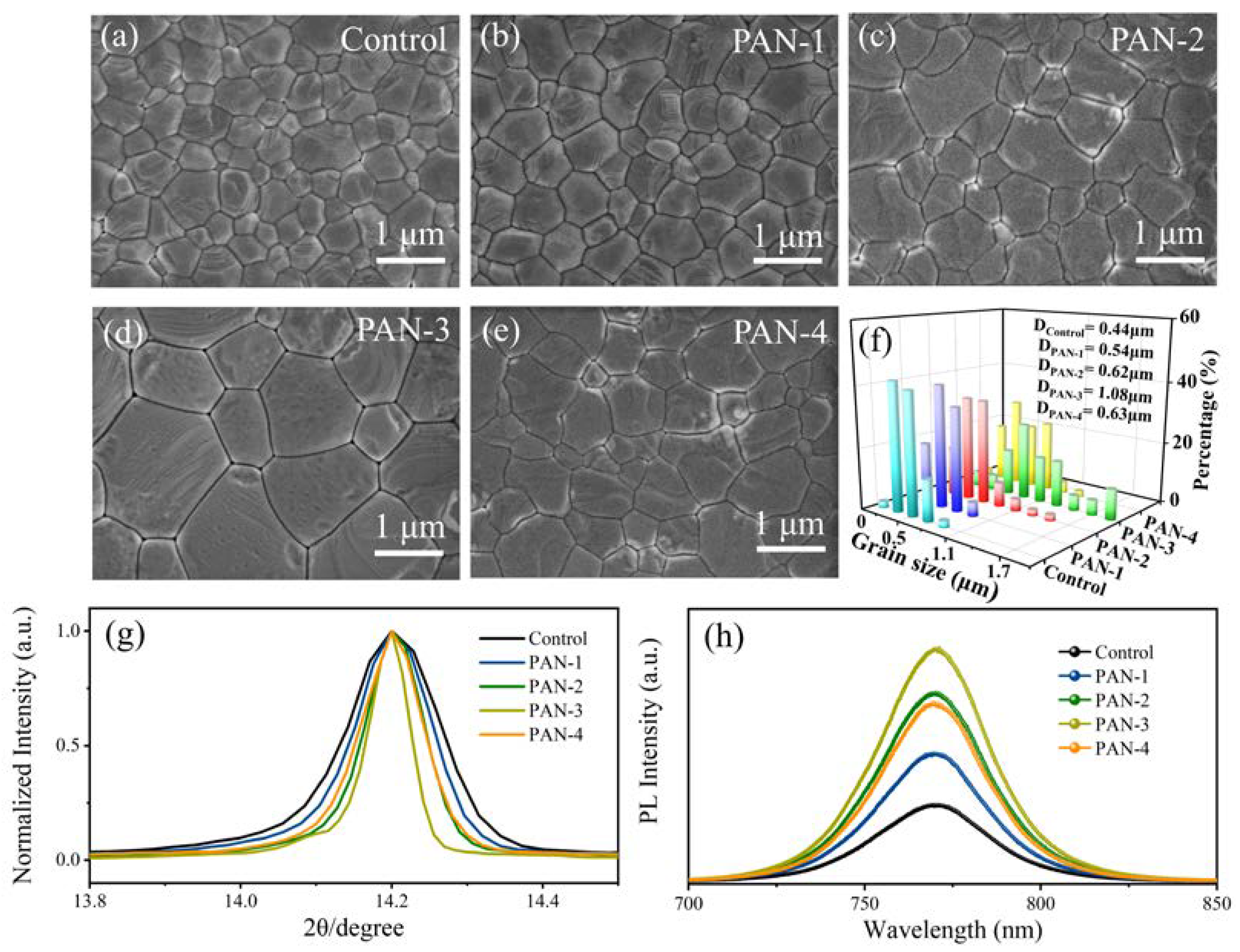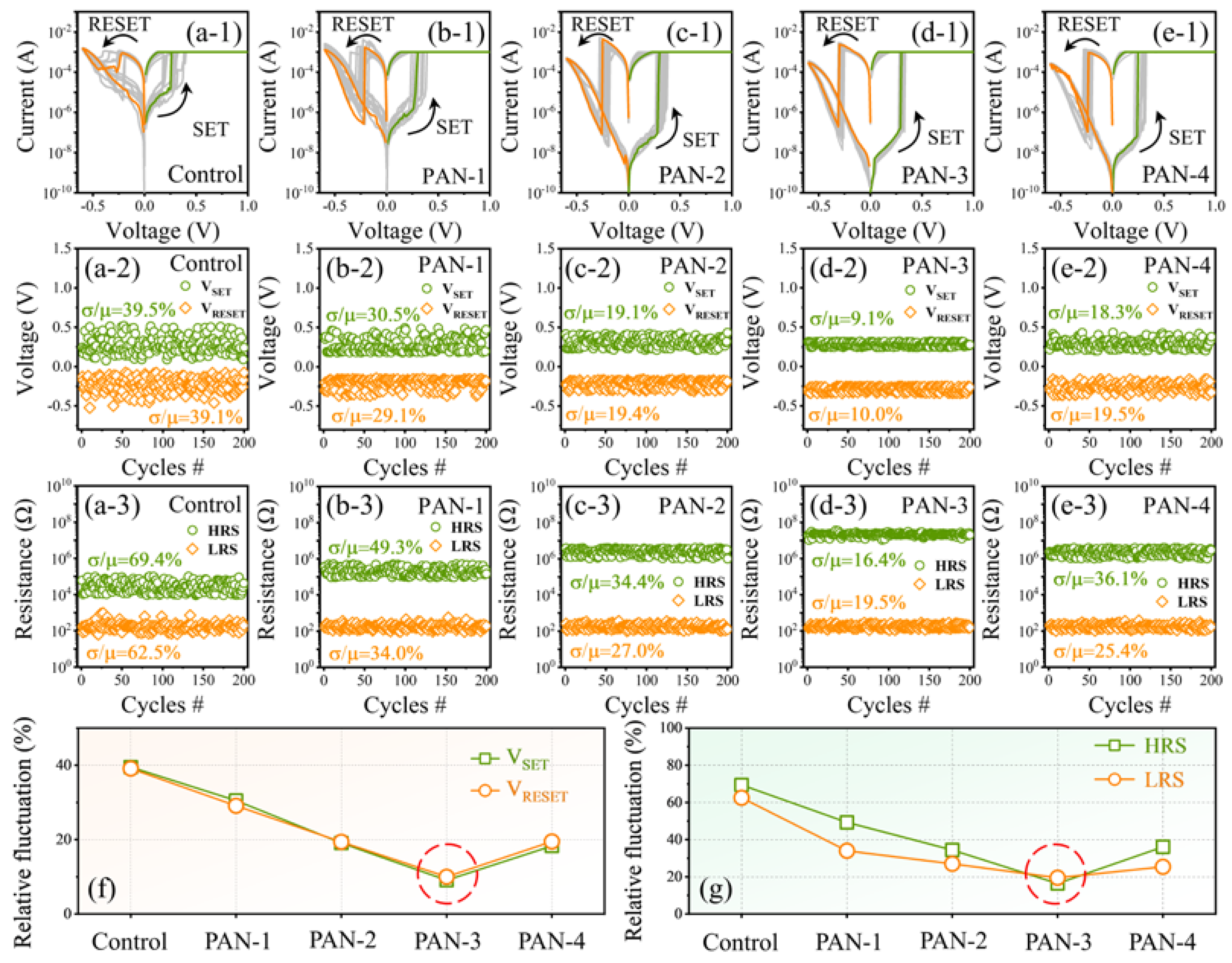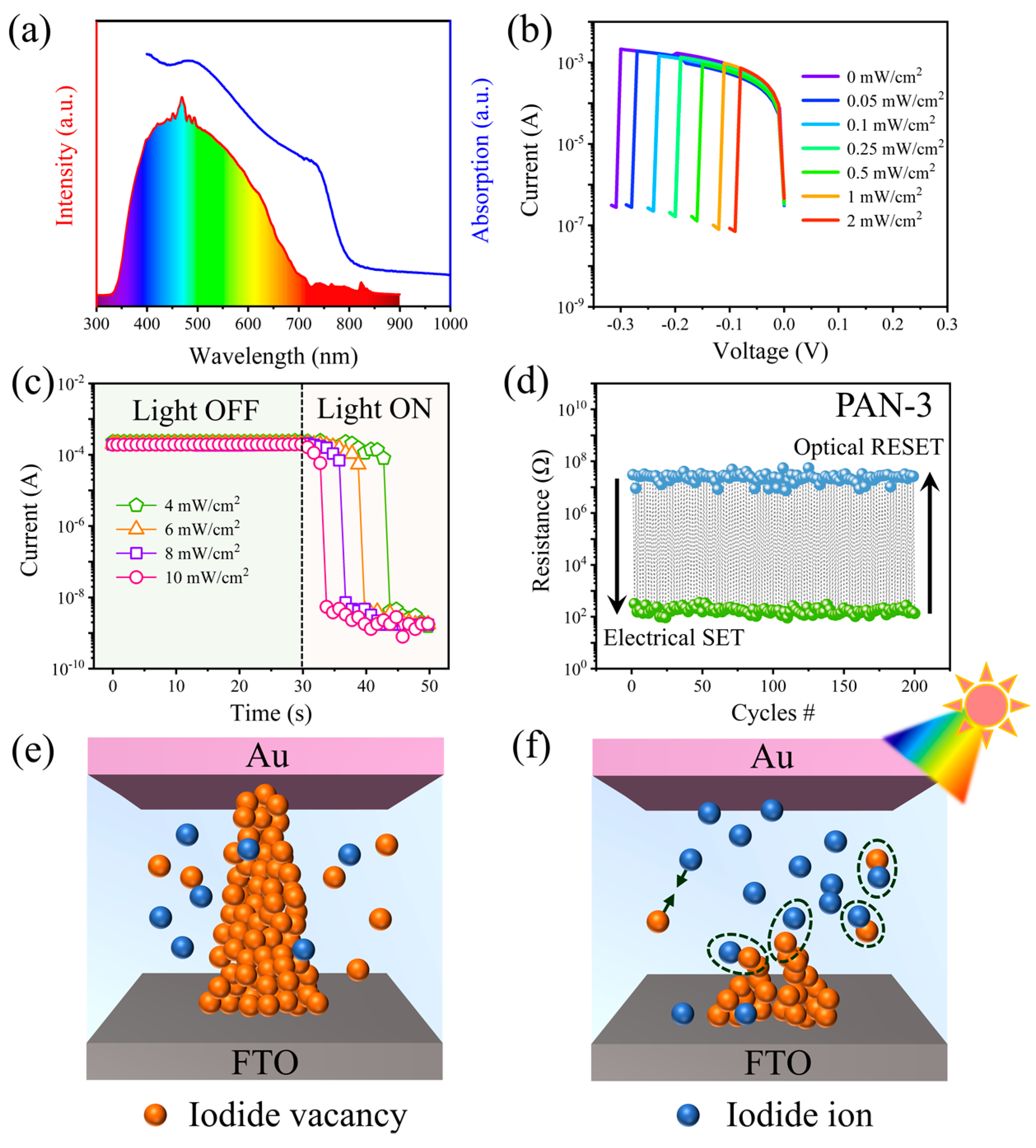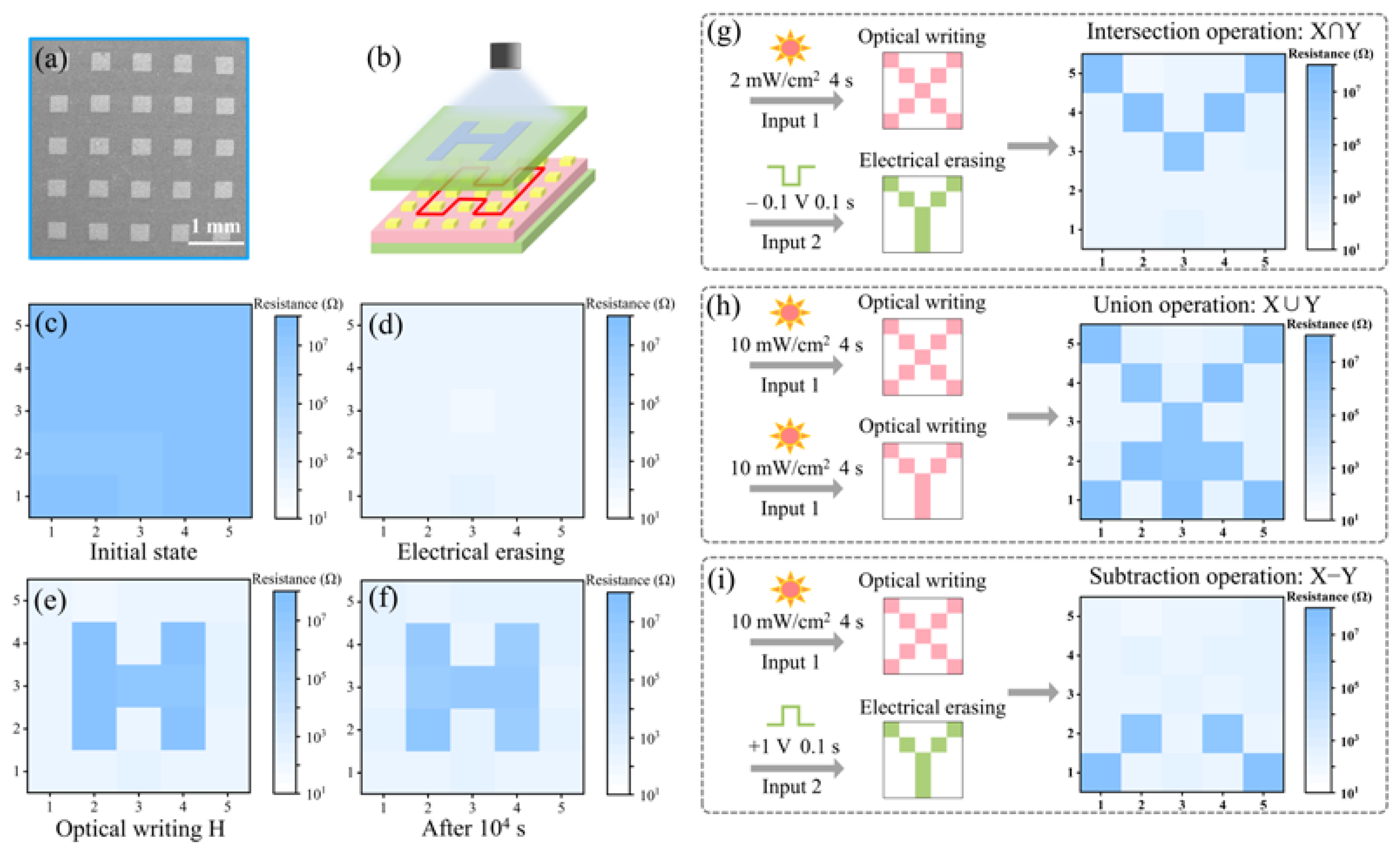Polyacrylonitrile Passivation for Enhancing the Optoelectronic Switching Performance of Halide Perovskite Memristor for Image Boolean Logic Applications
Abstract
1. Introduction
2. Materials and Methods
2.1. Sample Preparation
2.2. Characterization
3. Results
4. Conclusions
Supplementary Materials
Author Contributions
Funding
Data Availability Statement
Conflicts of Interest
References
- Tan, S.; Zhou, N.; Chen, Y.; Li, L.; Liu, G.; Liu, P.; Zhu, C.; Lu, J.; Sun, W.; Chen, Q.; et al. Effect of high dipole moment cation on layered 2D organic-inorganic halide perovskite solar cells. Adv. Energy Mater. 2019, 9, 1803024. [Google Scholar] [CrossRef]
- Wang, F.; Li, X.; Wang, H.; Gou, Y.; Yang, S.; Han, D.; Yang, L.; Fan, L.; Yang, J.; Rosei, F. Supramolecular bridging strategy enables high performance and stable organic-inorganic halide perovskite solar cells. Chem. Eng. J. 2022, 446, 137431. [Google Scholar] [CrossRef]
- Meng, X.; Ji, S.; Wang, Q.; Wang, X.; Bai, T.; Zhang, R.; Yang, B.; Li, Y.; Shao, Z.; Jiang, J.; et al. Organic-inorganic hybrid cuprous-based metal halides for warm white light-emitting diodes. Adv. Sci. 2022, 9, 2203596. [Google Scholar] [CrossRef] [PubMed]
- Yan, S.; Tian, W.; Chen, H.; Tang, K.; Lin, T.; Zhong, G.; Qiu, L.; Pan, X.; Wang, W. Synthesis of 0D manganese-based organic-inorganic hybrid perovskite and its application in lead-free red light-emitting diode. Adv. Funct. Mater. 2021, 31, 2100855. [Google Scholar] [CrossRef]
- Lee, J.; Lee, W.; Lee, J.; Baek, K.-Y.; Shin, J.; Kim, J.-K.; Kim, J.; Ahn, H.; Kang, K.; Lee, T. Tailored design-of-experiments approach for device performance prediction and optimization of flash-evaporated organic-inorganic halide perovskite-based photodetectors. Adv. Mater. Technol. 2021, 6, 2001131. [Google Scholar] [CrossRef]
- Ahmadi, M.; Wu, T.; Hu, B. A review on organic-inorganic halide perovskite photodetectors: Device engineering and fundamental physics. Adv. Mater. 2017, 29, 1605242. [Google Scholar] [CrossRef]
- Zhu, X.; Lee, J.; Lu, W.D. Iodine vacancy redistribution in organic-inorganic halide perovskite films and resistive switching effects. Adv. Mater. 2017, 29, 1700527. [Google Scholar] [CrossRef] [PubMed]
- Zhang, C.; Li, Y.; Ma, C.; Zhang, Q. Recent progress of organic-inorganic hybrid perovskites in rram, artificial synapse, and logic operation. Small Sci. 2022, 2, 2100086. [Google Scholar] [CrossRef]
- Calado, P.; Telford, A.M.; Bryant, D.; Li, X.; Nelson, J.; O’Regan, B.C.; Barnes, P.R.F. Evidence for ion migration in hybrid perovskite solar cells with minimal hysteresis. Nat. Commun. 2016, 7, 13831. [Google Scholar] [CrossRef] [PubMed]
- Gu, C.; Lee, J.S. Flexible hybrid organic-inorganic perovskite memory. ACS Nano 2016, 10, 5413–5418. [Google Scholar] [CrossRef]
- Siddik, A.; Haldar, P.K.; Das, U.; Roy, A.; Sarkar, P.K. Organic-inorganic FAPbBr3 perovskite based flexible optoelectronic memory device for light-induced multi level resistive switching application. Mater. Chem. Phys. 2023, 297, 127292. [Google Scholar] [CrossRef]
- Xiao, X.; Hu, J.; Tang, S.; Yan, K.; Gao, B.; Chen, H.; Zou, D. Recent advances in halide perovskite memristors: Materials, structures, mechanisms, and applications. Adv. Mater. Technol. 2020, 5, 1900914. [Google Scholar] [CrossRef]
- DeQuilettes, D.W.; Zhang, W.; Burlakov, V.M.; Graham, D.J.; Leijtens, T.; Osherov, A.; Bulovi, V.; Snaith, H.J.; Ginger, D.S.; Stranks, S.D. Photo-induced halide redistribution in organic-inorganic perovskite films. Nat. Commun. 2016, 7, 11683. [Google Scholar] [CrossRef] [PubMed]
- Mosconi, E.; Meggiolaro, D.; Snaith, H.J.; Stranks, S.D.; Angelis, F.D. Light-induced annihilation of Frenkel defects in organo-lead halide perovskites. Energy Environ. Sci. 2016, 9, 3180–3187. [Google Scholar] [CrossRef]
- Yun, J.S.; Seidel, J.; Kim, J.; Soufiani, A.M.; Huang, S.; Lau, J.; Jeon, N.J.; Seok, S.I.; Green, M.A.; Ho-Baillie, A. Critical role of grain boundaries for ion migration in formamidinium and methylammonium lead halide perovskite solar cells. Adv. Energy Mater. 2016, 6, 1600330. [Google Scholar] [CrossRef]
- Lee, J.W.; Bae, S.H.; De Marco, N.; Hsieh, Y.-T.; Dai, Z.; Yang, Y. The role of grain boundaries in perovskite solar cells. Mater. Today Energy 2018, 7, 149–160. [Google Scholar] [CrossRef]
- Zhou, Y.; Yew, K.S.; Ang, D.S.; Kawashima, T.; Bera, M.K.; Zhang, H.Z.; Bersuker, G. White-light-induced disruption of nanoscale conducting filament in hafnia. Appl. Phys. Lett. 2015, 107, 072107. [Google Scholar] [CrossRef]
- Park, J.; Lee, S.; Yong, K. Photo-stimulated resistive switching of ZnO nanorods. Nanotechnology 2012, 23, 385707. [Google Scholar] [CrossRef] [PubMed]
- Liu, Z.; Cheng, P.; Li, Y.; Kang, R.; Zhang, Z.; Zuo, Z.; Zhao, J. High temperature CsPbBrxI3−x memristors based on hybrid electrical and optical resistive switching effects. ACS Appl. Mater. Interfaces 2021, 13, 58885–58897. [Google Scholar] [CrossRef]
- Zhou, F.; Liu, Y.; Shen, X.; Wang, M.; Yuan, F.; Chai, Y. Low-voltage, optoelectronic CH3NH3PbI3−xClx memory with integrated sensing and logic operations. Adv. Funct. Mater. 2018, 28, 1800080. [Google Scholar] [CrossRef]
- Ma, Y.; Zhang, H.; Zhang, Y.; Hu, R.; Jiang, M.; Zhang, R.; Lv, H.; Tian, J.; Chu, L.; Zhang, J.; et al. Enhancing the performance of inverted perovskite solar cells via grain boundary passivation with carbon quantum dots. ACS Appl. Mater. Interfaces 2018, 11, 3044–3052. [Google Scholar] [CrossRef] [PubMed]
- Chen, C.; Wang, X.; Li, Z.; Du, X.; Shao, Z.; Sun, X.; Liu, D.; Gao, C.; Hao, L.; Zhao, Q.; et al. Polyacrylonitrile-coordinated perovskite solar cell with open-circuit voltage exceeding 1.23 V. Angew. Chem. 2022, 134, e202113932. [Google Scholar]
- Zheng, Z.; Xia, M.; Chen, X.; Xiao, X.; Gong, J.; Liu, J.; Du, J.; Tao, Y.; Hu, Y.; Mei, A.; et al. Enhancing the performance of FA-based printable mesoscopic perovskite solar cells via the polymer additive. Adv. Energy Mater. 2023, 13, 2204335. [Google Scholar] [CrossRef]
- Yang, N.; Li, T.; Zhang, P.P.; Chen, X.; Hu, X.; Zhang, W. An early cancer diagnosis platform based on micro-magnetic sensor array demonstrates ultra-high sensitivity. J. Nanomed. Nanotechnol. 2016, 7, 1000407. [Google Scholar] [CrossRef]
- Heo, J.H.; Shin, D.H.; Moon, S.H.; Lee, M.H.; Kim, D.H.; Oh, S.H.; Jo, W.; Im, S.H. Memory effect behavior with respect to the crystal grain size in the organic-inorganic hybrid perovskite nonvolatile resistive random access memory. Sci. Rep. 2017, 7, 16586. [Google Scholar] [CrossRef]
- Chen, Q.; Ma, T.; Wang, F.; Liu, Y.; Liu, S.; Wang, J.; Cheng, Z.; Chang, Q.; Yang, R.; Huang, W.; et al. Rapid microwave-annealing process of hybrid perovskites to eliminate miscellaneous phase for high performance photovoltaics. Adv. Sci. 2020, 7, 2000480. [Google Scholar] [CrossRef]
- Hou, X.; Huang, S.; Ou-Yang, W.; Pan, L.; Sun, Z.; Chen, X. Constructing efficient and stable perovskite solar cells via interconnecting perovskite grains. ACS Appl. Mater. Interfaces 2017, 9, 35200–35208. [Google Scholar] [CrossRef] [PubMed]
- Peng, Y.; Liu, X.; Zhang, H.; Zhou, R.; Luo, H.; Lei, Y.; Zou, W.; Ni, Y.; Li, H.; Wang, H. Trap state passivation by barbital additive toward efficient perovskite solar cells with 22.65% efficiency. Energy Technol. 2022, 10, 2200354. [Google Scholar] [CrossRef]
- Ma, H.; Wang, W.; Xu, H.; Wang, Z.; Tao, Y.; Chen, P.; Liu, W.; Zhang, X.; Ma, J.; Liu, Y. Interface state-induced negative differential resistance observed in hybrid perovskite resistive switching memory. ACS Appl. Mater. Interfaces 2018, 10, 21755–21763. [Google Scholar] [CrossRef]
- Chen, L.; Xu, Y.; Sun, Q.Q.; Zhou, P.; Wang, P.F.; Ding, S.J.; Zhang, D.W. Atomic-layer-deposited HfLaO-based resistive switching memories with superior performance. IEEE Electron Device Lett. 2010, 31, 1296–1298. [Google Scholar] [CrossRef]
- Ball, J.M.; Petrozza, A. Defects in perovskite-halides and their effects in solar cells. Nat. Energy 2016, 1, 16149. [Google Scholar] [CrossRef]
- Yuan, Y.; Huang, J. Ion migration in organometal trihalide perovskite and its impact on photovoltaic efficiency and stability. Acc. Chem. Res. 2016, 49, 286–293. [Google Scholar] [CrossRef] [PubMed]
- Wang, X.; Gao, S. Image encryption algorithm based on the matrix semi-tensor product with a compound secret key produced by a Boolean network. Inform. Sci. 2020, 539, 195–214. [Google Scholar] [CrossRef]
- Shi, J.; Lin, Y.; Zeng, T.; Wang, Z.; Zhao, X.; Xu, H.; Liu, Y. Voltage-dependent plasticity and image Boolean operations realized in a WOx-based memristive synapse. J. Semicond. 2021, 42, 014102. [Google Scholar] [CrossRef]
- Mäntylä, M. Boolean operations of 2-manifolds through vertex neighborhood classification. ACM Trans. Graph. 1986, 5, 1–29. [Google Scholar] [CrossRef]
- Gardan, Y.; Perrin, E. An algorithm reducing 3D Boolean operations to a 2D problem: Concepts and results. Comput. Aid. Des. 1996, 28, 277–287. [Google Scholar] [CrossRef]
- Ma, F.; Zhu, Y.; Xu, Z.; Liu, Y.; Zheng, X.; Ju, S.; Li, Q.; Ni, Z.; Hu, H.; Chai, Y.; et al. Optoelectronic perovskite synapses for neuromorphic computing. Adv. Funct. Mater. 2020, 30, 1908901. [Google Scholar] [CrossRef]
- Gentili, P.L. The fuzziness of a chromogenic spirooxazine. Dye. Pigment. 2014, 110, 235–248. [Google Scholar] [CrossRef]
- Sahoo, A.; Baitalik, S. Fuzzy logic, artificial neural network, and adaptive neuro-fuzzy inference methodology for soft computation and modeling of ion sensing data of a terpyridyl-imidazole based bifunctional receptor. Front. Chem. 2022, 10, 864363. [Google Scholar] [CrossRef]





Disclaimer/Publisher’s Note: The statements, opinions and data contained in all publications are solely those of the individual author(s) and contributor(s) and not of MDPI and/or the editor(s). MDPI and/or the editor(s) disclaim responsibility for any injury to people or property resulting from any ideas, methods, instructions or products referred to in the content. |
© 2023 by the authors. Licensee MDPI, Basel, Switzerland. This article is an open access article distributed under the terms and conditions of the Creative Commons Attribution (CC BY) license (https://creativecommons.org/licenses/by/4.0/).
Share and Cite
Zhang, X.; Zhao, X.; Wang, Z. Polyacrylonitrile Passivation for Enhancing the Optoelectronic Switching Performance of Halide Perovskite Memristor for Image Boolean Logic Applications. Nanomaterials 2023, 13, 2174. https://doi.org/10.3390/nano13152174
Zhang X, Zhao X, Wang Z. Polyacrylonitrile Passivation for Enhancing the Optoelectronic Switching Performance of Halide Perovskite Memristor for Image Boolean Logic Applications. Nanomaterials. 2023; 13(15):2174. https://doi.org/10.3390/nano13152174
Chicago/Turabian StyleZhang, Xiaohan, Xiaoning Zhao, and Zhongqiang Wang. 2023. "Polyacrylonitrile Passivation for Enhancing the Optoelectronic Switching Performance of Halide Perovskite Memristor for Image Boolean Logic Applications" Nanomaterials 13, no. 15: 2174. https://doi.org/10.3390/nano13152174
APA StyleZhang, X., Zhao, X., & Wang, Z. (2023). Polyacrylonitrile Passivation for Enhancing the Optoelectronic Switching Performance of Halide Perovskite Memristor for Image Boolean Logic Applications. Nanomaterials, 13(15), 2174. https://doi.org/10.3390/nano13152174





